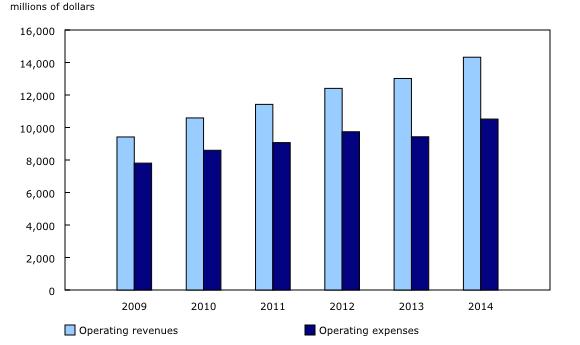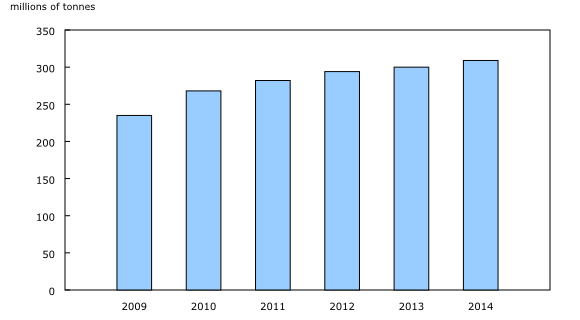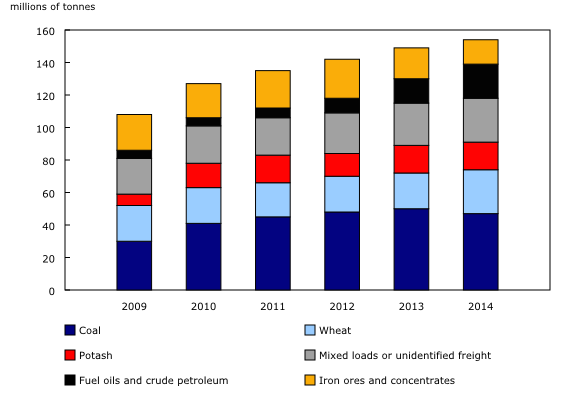Rail transportation, 2014
Archived Content
Information identified as archived is provided for reference, research or recordkeeping purposes. It is not subject to the Government of Canada Web Standards and has not been altered or updated since it was archived. Please "contact us" to request a format other than those available.
Released: 2016-03-29
Operating revenues for the Canadian railway industry continued their upward trend in 2014, rising 10.0% from 2013 to $14.3 billion. Freight transportation revenues, which accounted for 91.4% of total revenues, were up 10.8% to $13.1 billion, while revenues from passenger operations increased 4.3%.
In 2014, operating expenses rose 11.6% to $10.5 billion, primarily as a result of train-related expenses and increases in station and terminal operations expenses. Total diesel consumed was up 4.4% to 2.1 billion litres from 2013, with the cost increasing 10.6%.
The operating ratio of the Canadian railway industry edged up from $0.72 to $0.73.
The average number of employees declined 9.1% from 2013 to 29,577 in 2014. The average annual salary increased 5.4% to just under $90,000 a year.
The Canadian railway industry is capital intensive, and its total assets amounted to $26.8 billion in 2014. In terms of rolling stock, the number of passenger cars increased 9.0%, whereas locomotives (-1.9%) and freight cars (-0.3%) both decreased.
Output, as measured by tonne-kilometres, rose in 2014. Freight tonnage was 2.1% higher than in 2013, while the average hauling distance increased 5.4% to 1 161 tonne-kilometres. Each train had about 103 cars on average in 2014, up from 99 cars the previous year.
Trends and patterns, 2009 to 2014
Increases in operating revenues and expenses
From 2009 to 2014, total operating revenues earned by Canadian railways increased 56.6%, while total operating expenses increased 34.7%. The cost of fuel increased 90.0% over this period.
In terms of output, the tonnage of revenue freight was up 27.8% from 2009 to 357.8 million tonnes in 2014. The number of revenue passengers was down 10.7% during this same period.
Less track, more rolling stock, fewer employees
The amount of track operated decreased 7.7% to just over 62 000 kilometres from 2009 to 2014. Overall, the number of locomotives increased 8.6%, with the growth in the number of freight locomotives more than offsetting declines in the number of passenger locomotives and yard locomotives. There was a decline in the number of freight cars (-23.8%) and passenger cars (-4.4%).
The number of employees during this period decreased 6.7%; however, total compensation increased 12.4% and average compensation per hour increased 15.1% to $39 per hour.
Freight volumes continue to rise
In 2014, higher shipments of fuel oils and crude petroleum, and wheat contributed to a 2.9% increase in the volume of freight transported by Canadian rail carriers, which totalled 309.2 million tonnes. Since 2009, the total volume of rail freight has increased by almost one-third (+31.7%). Contributing to this growth were fuel oils and crude petroleum, up 307.4% to 20.9 million tonnes in 2014, and potash, up 155.8% to 17.5 million tonnes. The tonnage of sand, gravel, and crushed stone shipped by rail increased 128.0% from 2009 to 2014. Some of these materials are used as "fracking fluids" during horizontal drilling for crude petroleum.
From 2013 to 2014, containers on flat cars increased 4.2% to 35.6 million tonnes, while trailers on flat cars decreased 8.2% to 458 000 tonnes. Shipments of iron ores and concentrates, and coal edged down in 2014, but these products remained among the top commodities by weight. The top six commodities shipped by Canadian railways accounted for half of the total tonnage in 2014.
Rail shipments reflect regional economies
From 2009 to 2014, among the top commodities shipped by rail originating in the Maritime provinces were iron ores and concentrates, mixed loads or unidentified freight, lumber, and paper and paperboard. In Quebec, mixed loads or unidentified freight, other basic chemicals, and aluminium (primary or semi-finished) were among the top rail shipments by weight. Iron and steel (primary or semi-finished), automobiles, and minivans as well as mixed loads or unidentified freight continued to be the top rail shipments originating in Ontario.
Top rail shipments originating in Manitoba from 2009 to 2014 included animal or vegetable fats, oils and flours, and wheat and other cereal grains. Potash was among the top commodities from Saskatchewan. In Alberta, fuel oils and crude petroleum, coal, and wheat became the top rail shipments by weight. Coal, mixed loads or unidentified freight, and lumber continued to be the largest rail shipments from British Columbia.
In 2014, over one-half (57.0%) of all rail shipments by weight originated in three provinces: British Columbia (62.7 million tonnes), Alberta (60.8 million tonnes) and Saskatchewan (54.1 million tonnes).
Note to readers
This release presents data essential to the analysis of the rail transportation industry and its contribution to the Canadian economy. It is based on two data sources—an annual report survey and a commodity origin and destination statistics administrative file from Transport Canada.
The annual report survey collects financial, operating and employment data on railways operating in Canada. The commodity origin and destination statistics file monitors movements of commodities carried by Canadian National Railway (CN), Canadian Pacific Railway (CP), carriers that interline with CN and CP, as well as a number of regional and short-haul carriers that do not interline with either CN or CP.
Data aggregations are available for Canada and select geographic regions.
Contact information
For more information, or to enquire about the concepts, methods or data quality of this release, contact us (toll-free 1-800-263-1136; 514-283-8300; STATCAN.infostats-infostats.STATCAN@canada.ca) or Media Relations (613-951-4636; STATCAN.mediahotline-ligneinfomedias.STATCAN@canada.ca).
- Date modified:





